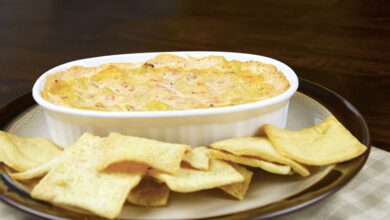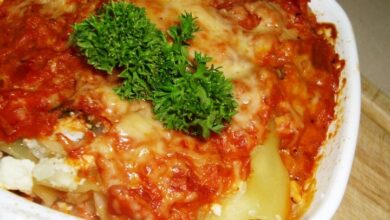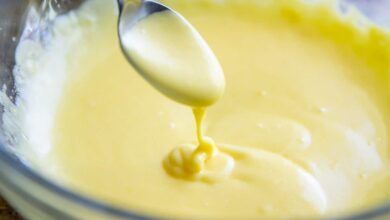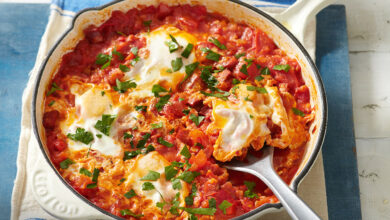Our Favorite Fluffy Biscuits

These are the most tender and fluffy homemade biscuits we’ve ever made. Our recipe calls for flour, butter, baking powder, and milk. These biscuits are big, tall, tender, and delicious. Jump to the Homemade Biscuits Recipe.
What is The Secret For The Best Biscuits?
We’ve made a lot of biscuits. Here are the two things we’ve found to make the best biscuits: cold butter and baking powder.
In this homestyle biscuit recipe, we cut very cold butter into all-purpose flour, salt, and baking powder. The butter makes these biscuits taste incredible. It also helps to make the crumb light, airy, and tender.
For these particular biscuits, we choose to mix baking powder and flour ourselves instead of buying self-rising flour. Self-rising flour is pre-mixed flour, baking powder, and salt. There’s nothing wrong with it, and when you use the right recipe, it cuts down on adding extra ingredients.
In this case, though, we add more baking powder than usual. If you use self-rising flour, there won’t be enough baking powder added to the biscuit dough. So, if self-rising flour is all you have, use it, but whisk in 2 extra teaspoons of baking powder.
I know that seems like a lot of baking powder, but trust me. The extra baking powder in this biscuit recipe is a game-changer for making the fluffiest and most tender homemade biscuits.
More: If you love biscuits, please take a look at these Cranberry Scones or these Blackberry Lemon Scones. The dough for scones is similar to biscuits!
How to Make Biscuits
You have two options for making these. My preferred method is to get out my food processor. It’s an excellent tool for cutting the cold butter into our flour mixture since it’s quick. We use it to make our favorite All-Butter Pie Crust for the same reason. When cutting the butter into the flour, you want to be as fast as possible so that the butter does not warm up.
If you don’t feel like getting your food processor out, you can use your hands or a pastry cutter to work the butter into the flour — we do this when making our easy Drop Biscuits.
Tip: If your butter starts to warm up, place the bowl with flour and butter into the fridge for 5 to 10 minutes.
When the butter and flour are dealt with, we mix in the milk and then form the dough. Pretty simple.
We don’t use a rolling pin when preparing the biscuits. Instead, we press the dough with our fingers. You can see us work the dough in our video.
First, we push the dough into a rough rectangle and then fold the sides into the middle, like a letter. Then we rotate the new rectangle, press it out, and do it again.
Frequently Asked Questions
What type of flour is best for making biscuits? We use all-purpose flour since that’s what is available where we live. However, some stores sell soft white wheat flour (lower protein), like White Lilly, Martha White, and Bob’s Red Mill Fine Pastry Flour. These are all excellent options for biscuits since their lower protein content shuts down gluten formation, which means they will be light, fluffy, and tender. I should note, though, that with this biscuit recipe, all-purpose flour is perfectly adequate. Thanks to the extra baking powder, the biscuits are light and fluffy no matter what flour you use.
What type of butter is best for making biscuits? Most often, in our baking recipes, we call for unsalted butter. In this recipe, though, I love reaching for European salted butter, like Kerrygold or Plugra, since they make the biscuits tender and delicious. Now, if you don’t have European salted butter on hand, plain butter works (salted or unsalted). I love the slightly more salty flavor when salted butter is used in our recipe, but you can always hold back on some of the salt called for in the recipe if you aren’t looking for more savory/salty biscuits.
Our Favorite Fluffy Biscuits
- PREP
- COOK
- TOTAL
These are the most tender and fluffy homemade biscuits we’ve ever made. Our recipe calls for flour, butter, baking powder, and milk. These biscuits are big, tall, tender, and delicious. My preferred method is to get out my food processor. It’s an excellent tool for cutting the cold butter into our flour mixture since it’s quick. If you don’t feel like getting your food processor out, you can use your hands or a pastry cutter to work the butter into the flour (tips are provided in the notes section).
Makes 7 to 8 biscuits
You Will Need
2 cups (260 grams) all-purpose flour, see notes for self-rising flour
5 teaspoons baking powder
1/4 teaspoon baking soda
1 tablespoon sugar
1 teaspoon fine sea salt
6 tablespoons cold butter, see notes
3/4 cup + 2 tablespoons (207 ml) whole milk or buttermilk
Directions
Heat the oven to 425° Fahrenheit and set aside an oven-safe 10-inch or 12-inch skillet like a cast iron pan or, if you do not have one, set aside a baking sheet instead.
Combine the flour, baking powder, baking soda, sugar, and salt in the bowl of a food processor. Pulse three to four times so that it is mixed.
Cut the cold butter into cubes or thin slices, then scatter it over the flour in the food processor. Pulse 5 to 7 times or until the butter turns into tiny bits — see our photos and video for reference.
Empty the butter-flour mixture into a large bowl. Make a well in the middle, and then pour in the milk (or buttermilk). Stir until a shaggy dough forms.
Transfer the dough onto a lightly floured work surface. Sprinkle a little flour on top, and then bring the dough together with your hands. It might be a bit sticky, so add flour as needed.
Without working the dough too much, pat it down into a rectangle about 3/4 inch thick. Fold the dough into thirds, like a letter — see our photos and video for reference. Rotate the rectangle 90 degrees, and then repeat this process two more times.
Pat the dough into a rectangle between 1/2 inch and 3/4 inch thick. Then use a biscuit cutter to cut out your biscuits — we use a 3-inch round cutter. Do not twist the cutter, as this will seal the edges of the biscuits and prevent them from rising.
Place the cut-out biscuits into the skillet (or onto a baking sheet). Keeping them close to each other helps them rise.
Gently press together the scraps and use them to make more biscuits, but be careful not to overwork the dough, or else they will be tough.
Bake the biscuits until golden brown and have risen, 10 to 15 minutes. Serve warm.
Adam and Joanne’s Tips
- No Food Processor: Whisk or sift the dry ingredients together. Cut the butter into small cubes. Scatter the cold butter cubes over the flour mixture, then use a pastry blender or your fingers to cut or rub the butter in until the mixture looks like coarse crumbs.
- Milk or Buttermilk: Use milk or buttermilk in this recipe. Buttermilk adds a tangy flavor to the biscuits and makes them slightly more tender.
- Butter: We use salted European butter in this recipe. It will work with unsalted or salted butter. I like the extra saltiness of salted butter, but you can reduce the salt to 3/4 teaspoon if you prefer.
- Self-rising flour: If you use self-rising flour, there won’t be enough baking powder added to the biscuit dough. So, if self-rising flour is all you have, use it, but whisk in 2 extra teaspoons of baking powder. Use 1/2 teaspoon salt instead.
- Recipe inspired and adapted from Sam Sifton’s All-Purpose Biscuits as well as our Buttermilk Biscuits
- Nutrition facts: The nutrition facts provided below are estimates. We have used the USDA database to calculate approximate values.
Nutrition Per Serving: Serving Size 1 Biscuit (8 total) / Calories 211 / Total Fat 9g / Saturated Fat 5.5g / Cholesterol 23.4mg / Sodium 279.4mg / Carbohydrate 29.6g / Dietary Fiber 1g / Total Sugars 2.9g / Protein 4.2g.



